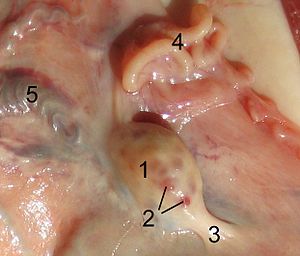Ovarian follicle
Under an ovarian follicle (also ovarian follicles or follicle ) refers to the unit consisting of the egg and the surrounding auxiliary cells in the ovary ( ovary ). The auxiliary cells are the follicular epithelial cells ( granulosa cells ) and two layers of connective tissue that surround them: theca cells ( Latin theca folliculi ), consisting of the inner theca interna and the outer theca externa .
Follicular maturation
The primordial follicles are created before birth. They are the result of the primordial germ cells that migrated from the yolk sac into the gonadal system (in the 6th week) and their mitotic division up to the 5th month. They are in prophase I of meiosis and consist of the egg cell and a single-layer, flat follicular epithelium. The primordial follicles are stopped in their development until puberty. This pause is called dictyotene . During puberty, the pituitary gland secretes follicle-stimulating hormone (FSH), which stimulates the maturation of 5 to 15 primordial follicles. They become primary follicles , which are characterized by the fact that they form a cubic follicular epithelium that is polar. The oocyte begins to grow. It becomes a secondary follicle (the follicular epithelium is multilayered, the theca cells are formed from connective tissue), in which the egg cell forms a layer of glycoproteins ( zona pellucida ) and the follicular epithelium is multilayered and aligned in a radial manner ( corona radiata ).
The next stage, the tertiary follicles, are characterized by the appearance of a follicular cavity ( antrum follicular ), which is filled with a fluid ( liquor follicularis ) and is already recognizable when developing into a secondary follicle. This development from the primordial to the antral follicle takes about three months. The egg cell is now in a cluster of granulosa cells , the egg mound ( Cumulus oophorus ). Only now does the surrounding connective tissue (the follicular cavity) also differentiate into theca interna and theca externa .
In the course of follicle maturation, the vascular and cell-rich theca interna produces androgens , which diffuse through the basement membrane into the granulosa cells, where they are flavored to estrogen , especially estradiol.
The entire process of follicle growth from the primary follicle stage to the preovulatory, gonadotropin-dependent antral follicle takes about 6 months.
Due to the further increase in size, the mature Graaf's follicles (named after Reinier De Graaf ) arise .
These processes are controlled by the follicle-stimulating hormone (FSH) from the pituitary gland . For Follikelsprung occurs when the theca cells (ie, when the oocyte is mature) estradiol start to produce about 24 hours before the follicle (ovulation) much. This rise in estradiol causes the pituitary to release luteinizing hormone , which in turn triggers the rupture of follicles. During ovulation, the mature oocyte (including the zona pellucida and corona radiata ) is expelled from the follicle and taken up outside the ovary by the fallopian tube , more precisely its fimbriae , and carried on into the pars ampullaris .
Following ovulation, the follicle (granulosa and theca cells) forms the corpus luteum , which produces progesterone . Progesterone prevents the previously built up uterine lining from breaking down (menstruation). The corpus luteum breaks down without fertilization (after about 9 days) and progesterone production is therefore lost. This initiates menstruation. But if the egg cell is fertilized, it releases a hormone (HCG, human chorionic gonadotropin ), which instead of the luteinizing hormone further stimulates the corpus luteum. The corpus luteum then grows and becomes the corpus luteum graviditatis . In the first two months of pregnancy he is solely responsible for the production of progesterone, after that production is increasingly taken over by the placenta.
Fall of follicles
Follicles can perish at any stage and at any age. This process is called follicular atresia .
literature
- Thomas W. Sadler; Medical embryology ; Thieme publishing house; 2003; ISBN 3-13-446610-4
Individual evidence
- ↑ Christoph Keck: Endocrinology, reproductive medicine, andrology . 2nd Edition. Thieme Publishing Group , Stuttgart 2012, ISBN 3-13-107162-1 .
- ↑ Andrea Dunaif: Polycystic Ovary Syndrome: Current Controversies, from the Ovary to the Pancreas . 2nd Edition. Humana Press, part of Springer Science + Business Media , 2008, ISBN 978-1-59745-108-6 .
